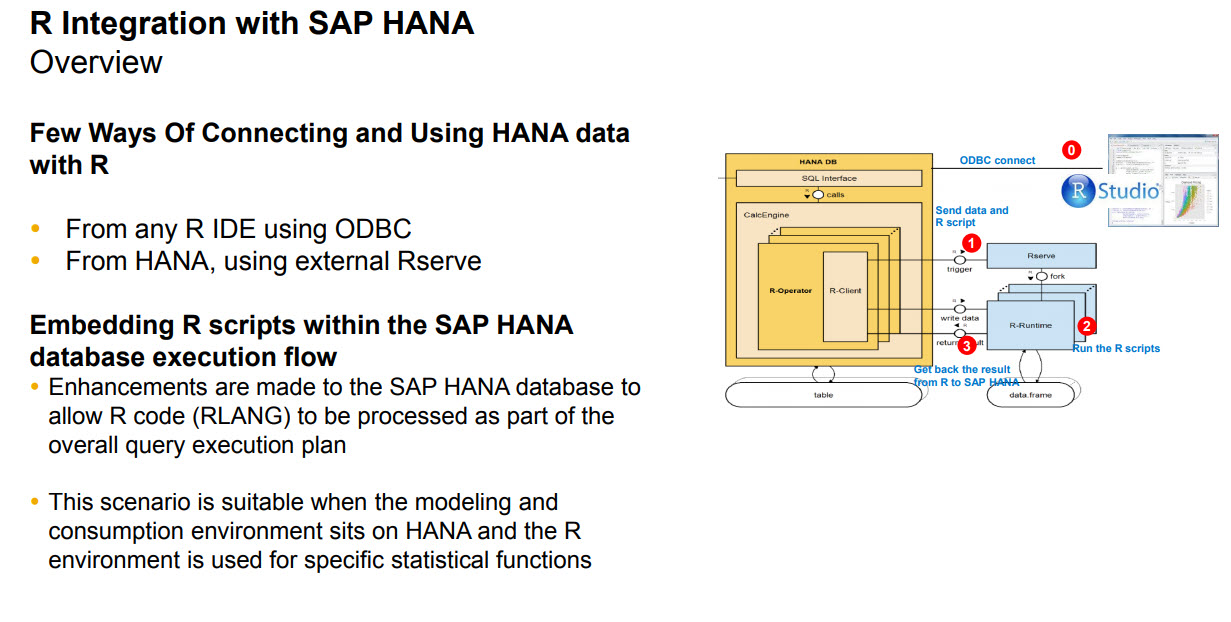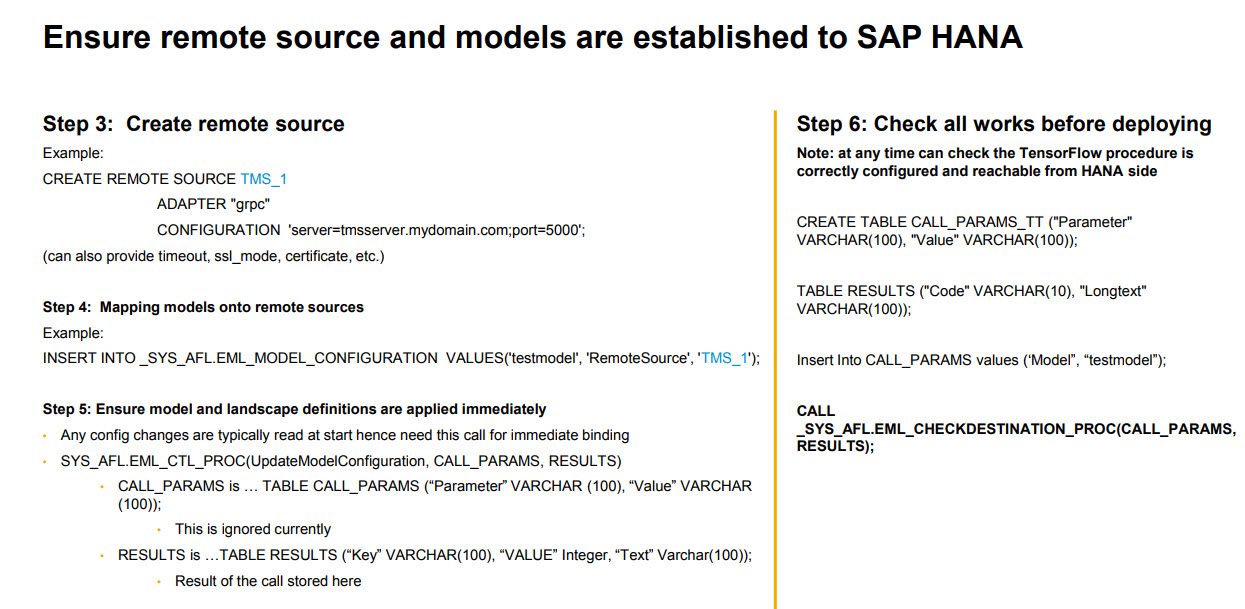
- SAP Community
- Groups
- Interest Groups
- Artificial Intelligence and Machine Learning
- Blogs
- SAP HANA Machine Learning and Integration with Oth...
Artificial Intelligence and Machine Learning Blogs
Explore AI and ML blogs. Discover use cases, advancements, and the transformative potential of AI for businesses. Stay informed of trends and applications.
Turn on suggestions
Auto-suggest helps you quickly narrow down your search results by suggesting possible matches as you type.
Showing results for
TammyPowlas
Active Contributor
Options
- Subscribe to RSS Feed
- Mark as New
- Mark as Read
- Bookmark
- Subscribe
- Printer Friendly Page
- Report Inappropriate Content
09-11-2017
10:21 AM
Abstract (source: ASUG/SAP)
This session will cover some of the external machine learning systems, and how SAP HANA can be used to integrate with them. Additionally, we will cover some of the other machine learning technologies in the SAP portfolio, and how SAP HANA integrates with them. This webcast was hosted by BITI.

Figure 1: Source: SAP
Store models, train models, use it for scoring, part of the machine learning libraries in HANA

Figure 2: Source: SAP
Webcast focus is on 3rd party algorithms integration

Figure 3: Source: SAP
What is new in SP02 for predictive
Tensorflow is new
Also see this recording: https://sapnaevent.adobeconnect.com/paj90xqp3j3t/?proto=true

Figure 4: Source: SAP
Access HANA data from R studio
Write stored procedures that contain R

Figure 5: Source: SAP
Connect via ODBC
Or in HANA itself embed R

Figure 6: Source: SAP
Language type is RLANG and body of code is R, executed on R server
Results come back as a table for you to use

Figure 7: Source: SAP
Key features - R is integrated into the HANA landscape and how you can use it

Figure 8: Source: SAP
Figure 8 shows some best practices
Summary of R Capability (Source: SAP)
• SAP HANA allows use of HANA data from client side, or execute R logic from within the server
• Can be combined with SQL code and other HANA analytical functions (e.g. PAL)
• Can have multiple R Serve for better performance, availability

Figure 9: Source: SAP
Figure 9 shows that SAP recommends starting with PAL, for performance reasons
Options for areas not covered by PAL - R or TensorFlow

Figure 10: Source: SAP
Figure 10 explains what TensorFlow is

Figure 11: Source: SAP
Figure 11 covers the architecture, integrated with Application Function Library, integrated with PAL
Easier to integrate SQL with non-SQL
Steps for using this with HANA (Source: SAP)
Two steps
Train the Model (done outside of SAP HANA)
▪ Create and train a model using TensorFlow
▪ Deploy the model to a TensorFlow Serving server (on a separate machine)
Using the Model (within SAP HANA)
▪ Register the model with the EMLAFL to create a custom procedure (similar to the PAL method)
▪ Access the model via the procedure for scoring

Figure 12: Source: SAP
You can mix and match as shown in Figure 12

Figure 13: Source: SAP
Different deployment choices are shown in Figure 13

Figure 14: Source: SAP
Verify components are installed
Check privileges are granted

Figure 15: Source: SAP
Figure 15 covers the steps on the HANA side

Figure 16: Source: SAP
Make sure HANA is aware that you have a remote source that contains Tensorflow models

Figure 17: Source: SAP
Each saved model has a signature
Map to HANA columns

Figure 18: Source: SAP
On Tensorflow, load multiple models
SAP HANA EMLAFL framework enables TensorFlow models to be exposed as stored procedures
within SAP HANA
TensorFlow models can be combined with other SAP HANA models
Currently scoring is supported
TensorFlow models can be deployed on premise or in the cloud and consumed within SAP HANA
SAP HANA Documentation
https://help.sap.com/viewer/p/SAP_HANA_PLATFORM
Blogs:
https://blogs.sap.com/2017/07/28/simplified-in-database-machine-learning-with-sap-hana/
https://blogs.sap.com/2017/08/01/implementing-the-mnist-classification-problem-the-hello-world-of-ml...
https://www.youtube.com/user/saphanaacademy
https://www.youtube.com/user/saphanaacademy/playlists?shelf_id=10&view=50&sort=dd
Coming this week - another BITI Webcast:
alan.rickayzen SAP Mentor Alumnus, gives a webcast on A Whirlwind Tour of Workflow in S/4 HANA Cloud & On-premise (Session 1) – see you there?
This session will cover some of the external machine learning systems, and how SAP HANA can be used to integrate with them. Additionally, we will cover some of the other machine learning technologies in the SAP portfolio, and how SAP HANA integrates with them. This webcast was hosted by BITI.

Figure 1: Source: SAP
Store models, train models, use it for scoring, part of the machine learning libraries in HANA

Figure 2: Source: SAP
Webcast focus is on 3rd party algorithms integration

Figure 3: Source: SAP
What is new in SP02 for predictive
Tensorflow is new
Also see this recording: https://sapnaevent.adobeconnect.com/paj90xqp3j3t/?proto=true

Figure 4: Source: SAP
Access HANA data from R studio
Write stored procedures that contain R

Figure 5: Source: SAP
Connect via ODBC
Or in HANA itself embed R

Figure 6: Source: SAP
Language type is RLANG and body of code is R, executed on R server
Results come back as a table for you to use

Figure 7: Source: SAP
Key features - R is integrated into the HANA landscape and how you can use it

Figure 8: Source: SAP
Figure 8 shows some best practices
Summary of R Capability (Source: SAP)
• SAP HANA allows use of HANA data from client side, or execute R logic from within the server
• Can be combined with SQL code and other HANA analytical functions (e.g. PAL)
• Can have multiple R Serve for better performance, availability
Key topic: SAP HANA integration with TensorFlow

Figure 9: Source: SAP
Figure 9 shows that SAP recommends starting with PAL, for performance reasons
Options for areas not covered by PAL - R or TensorFlow

Figure 10: Source: SAP
Figure 10 explains what TensorFlow is

Figure 11: Source: SAP
Figure 11 covers the architecture, integrated with Application Function Library, integrated with PAL
Easier to integrate SQL with non-SQL
Steps for using this with HANA (Source: SAP)
Two steps
Train the Model (done outside of SAP HANA)
▪ Create and train a model using TensorFlow
▪ Deploy the model to a TensorFlow Serving server (on a separate machine)
Using the Model (within SAP HANA)
▪ Register the model with the EMLAFL to create a custom procedure (similar to the PAL method)
▪ Access the model via the procedure for scoring

Figure 12: Source: SAP
You can mix and match as shown in Figure 12

Figure 13: Source: SAP
Different deployment choices are shown in Figure 13

Figure 14: Source: SAP
Verify components are installed
Check privileges are granted

Figure 15: Source: SAP
Figure 15 covers the steps on the HANA side

Figure 16: Source: SAP
Make sure HANA is aware that you have a remote source that contains Tensorflow models

Figure 17: Source: SAP
Each saved model has a signature
Map to HANA columns

Figure 18: Source: SAP
On Tensorflow, load multiple models
Summary (source: SAP)
SAP HANA EMLAFL framework enables TensorFlow models to be exposed as stored procedures
within SAP HANA
TensorFlow models can be combined with other SAP HANA models
Currently scoring is supported
TensorFlow models can be deployed on premise or in the cloud and consumed within SAP HANA
References from SAP:
SAP HANA Documentation
https://help.sap.com/viewer/p/SAP_HANA_PLATFORM
Blogs:
https://blogs.sap.com/2017/07/28/simplified-in-database-machine-learning-with-sap-hana/
https://blogs.sap.com/2017/08/01/implementing-the-mnist-classification-problem-the-hello-world-of-ml...
https://www.youtube.com/user/saphanaacademy
https://www.youtube.com/user/saphanaacademy/playlists?shelf_id=10&view=50&sort=dd
Coming this week - another BITI Webcast:
alan.rickayzen SAP Mentor Alumnus, gives a webcast on A Whirlwind Tour of Workflow in S/4 HANA Cloud & On-premise (Session 1) – see you there?
- SAP Managed Tags:
- Machine Learning
1 Comment
You must be a registered user to add a comment. If you've already registered, sign in. Otherwise, register and sign in.
Labels in this area
-
Agents
3 -
AI
5 -
AI Launchpad
2 -
Artificial Intelligence
2 -
Artificial Intelligence (AI)
3 -
Brainstorming
1 -
BTP
1 -
Business AI
2 -
Business Trends
1 -
Cloud Foundry
1 -
Data and Analytics (DA)
1 -
Design and Engineering
1 -
forecasting
1 -
GenAI
1 -
Generative AI
4 -
Generative AI Hub
4 -
Graph
1 -
Language Models
1 -
LlamaIndex
1 -
LLM
2 -
LLMs
2 -
Machine Learning
1 -
Machine learning using SAP HANA
1 -
Mistral AI
1 -
NLP (Natural Language Processing)
1 -
open source
1 -
OpenAI
1 -
Python
2 -
RAG
2 -
Retrieval Augmented Generation
1 -
SAP Build Process Automation
1 -
SAP HANA
1 -
SAP HANA Cloud
1 -
User Experience
1 -
user interface
1 -
Vector Database
3 -
Vector DB
1 -
Vector Similarity
1
Top kudoed authors
| User | Count |
|---|---|
| 3 | |
| 3 | |
| 2 | |
| 1 | |
| 1 | |
| 1 |